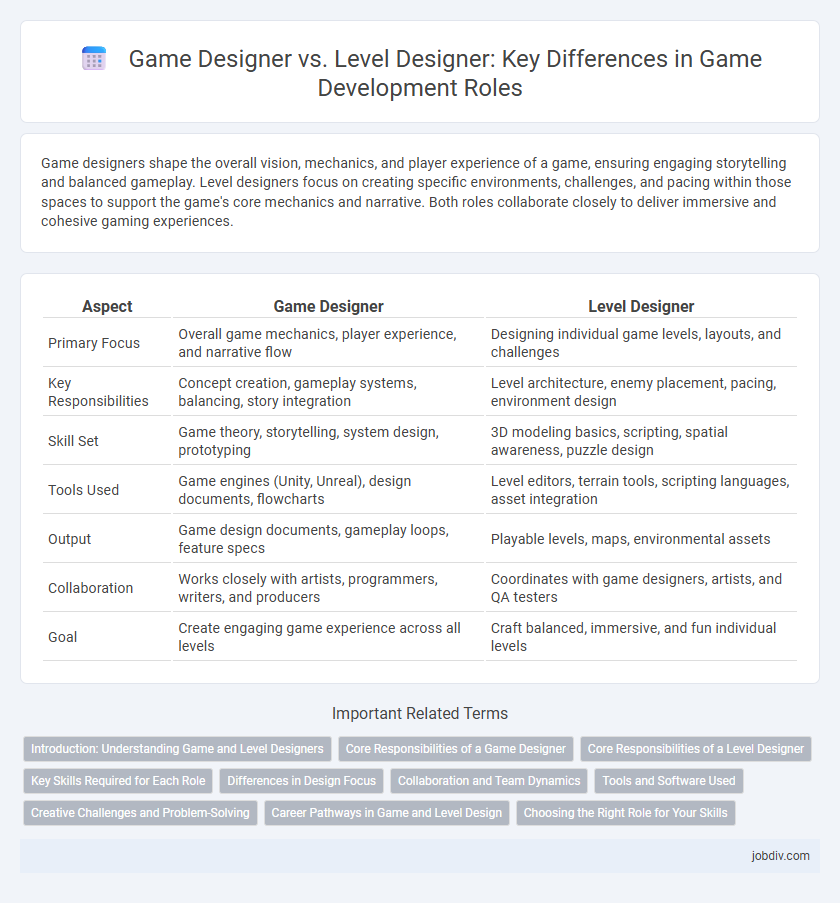Game designers shape the overall vision, mechanics, and player experience of a game, ensuring engaging storytelling and balanced gameplay. Level designers focus on creating specific environments, challenges, and pacing within those spaces to support the game's core mechanics and narrative. Both roles collaborate closely to deliver immersive and cohesive gaming experiences.
Table of Comparison
| Aspect | Game Designer | Level Designer |
|---|---|---|
| Primary Focus | Overall game mechanics, player experience, and narrative flow | Designing individual game levels, layouts, and challenges |
| Key Responsibilities | Concept creation, gameplay systems, balancing, story integration | Level architecture, enemy placement, pacing, environment design |
| Skill Set | Game theory, storytelling, system design, prototyping | 3D modeling basics, scripting, spatial awareness, puzzle design |
| Tools Used | Game engines (Unity, Unreal), design documents, flowcharts | Level editors, terrain tools, scripting languages, asset integration |
| Output | Game design documents, gameplay loops, feature specs | Playable levels, maps, environmental assets |
| Collaboration | Works closely with artists, programmers, writers, and producers | Coordinates with game designers, artists, and QA testers |
| Goal | Create engaging game experience across all levels | Craft balanced, immersive, and fun individual levels |
Introduction: Understanding Game and Level Designers
Game Designers create the overall concept, mechanics, and player experience by crafting rules, storylines, and gameplay systems. Level Designers focus on designing individual game environments, ensuring engaging layout, pacing, and challenges that align with the game's vision. Both roles collaborate to blend narrative and interactive elements, delivering immersive and balanced gameplay.
Core Responsibilities of a Game Designer
A Game Designer defines overall game mechanics, storylines, and player experience, crafting the foundational rules and objectives that drive gameplay. They collaborate with artists, programmers, and writers to ensure cohesive vision and balance across all game elements. Game Designers focus on the holistic design process, including narrative integration, user engagement, and system-level interactions.
Core Responsibilities of a Level Designer
Level designers concentrate on crafting engaging gameplay experiences by designing maps, environments, and challenges that align with the game's overall vision. Their core responsibilities include creating balanced layouts, placing interactive elements, and optimizing flow to ensure player progression feels natural and rewarding. Level designers collaborate closely with game designers to implement narrative and mechanics while maintaining technical feasibility and replay value.
Key Skills Required for Each Role
Game designers must excel in creative storytelling, gameplay mechanics, and player experience analysis to craft engaging narratives and overall game concepts. Level designers require strong spatial awareness, proficiency in game engine tools, and an understanding of pacing to create immersive and balanced game environments. Both roles benefit from skills in scripting languages and collaboration with cross-functional teams for successful project execution.
Differences in Design Focus
Game designers concentrate on the overall gameplay mechanics, story development, and player experience, shaping the entire game framework. Level designers focus specifically on creating and balancing individual levels or environments, ensuring spatial flow, challenge progression, and player interaction within those confined areas. This distinction highlights the broader narrative and system coordination by game designers versus the tactical and spatial intricacies managed by level designers.
Collaboration and Team Dynamics
Game designers and level designers collaborate closely to ensure cohesive gameplay experiences by aligning narrative elements with spatial challenges. Effective team dynamics arise from continuous communication, where game designers provide overarching story frameworks while level designers translate these into interactive environments. This synergy enhances player engagement and maintains consistent design vision across development stages.
Tools and Software Used
Game designers primarily use comprehensive software like Unity, Unreal Engine, and Adobe Creative Suite to conceptualize gameplay mechanics, narrative flow, and overall user experience. Level designers focus on specialized tools such as World Machine, Autodesk Maya, and Tiled Map Editor to create intricate environments, detailed maps, and spatial layouts within game worlds. Mastery of scripting languages like C# and Python often differentiates game designers, while proficiency with 3D modeling and terrain sculpting software is essential for level designers.
Creative Challenges and Problem-Solving
Game designers tackle overarching creative challenges by defining gameplay mechanics, narrative flow, and player engagement strategies, requiring broad problem-solving to balance innovation with player experience. Level designers focus on spatial creativity and interactive environments, solving intricate puzzles in layout, pacing, and difficulty to maintain player immersion. Both roles demand iterative testing and collaboration to refine concepts and deliver cohesive, enjoyable gameplay.
Career Pathways in Game and Level Design
Game Designer career pathways emphasize crafting core gameplay mechanics, narrative development, and player experience, requiring strong storytelling and system-design skills. Level Designers focus on creating engaging environments, pacing, and player navigation through detailed map layouts and interactive elements, demanding expertise in spatial design and technical tools like Unreal Engine or Unity. Progression in both fields often includes specialization roles such as systems designer, UX designer, or environment artist, leveraging collaborative work with developers and artists in game studios.
Choosing the Right Role for Your Skills
Game designers focus on the overall mechanics, story, and player experience, requiring strong skills in creativity, storytelling, and systems thinking. Level designers specialize in crafting individual game environments and challenges, demanding expertise in spatial awareness, pacing, and user engagement. Evaluating your strengths in big-picture game vision versus detailed environmental design helps determine whether a game designer or level designer role suits your talents best.
Game Designer vs Level Designer Infographic

 jobdiv.com
jobdiv.com